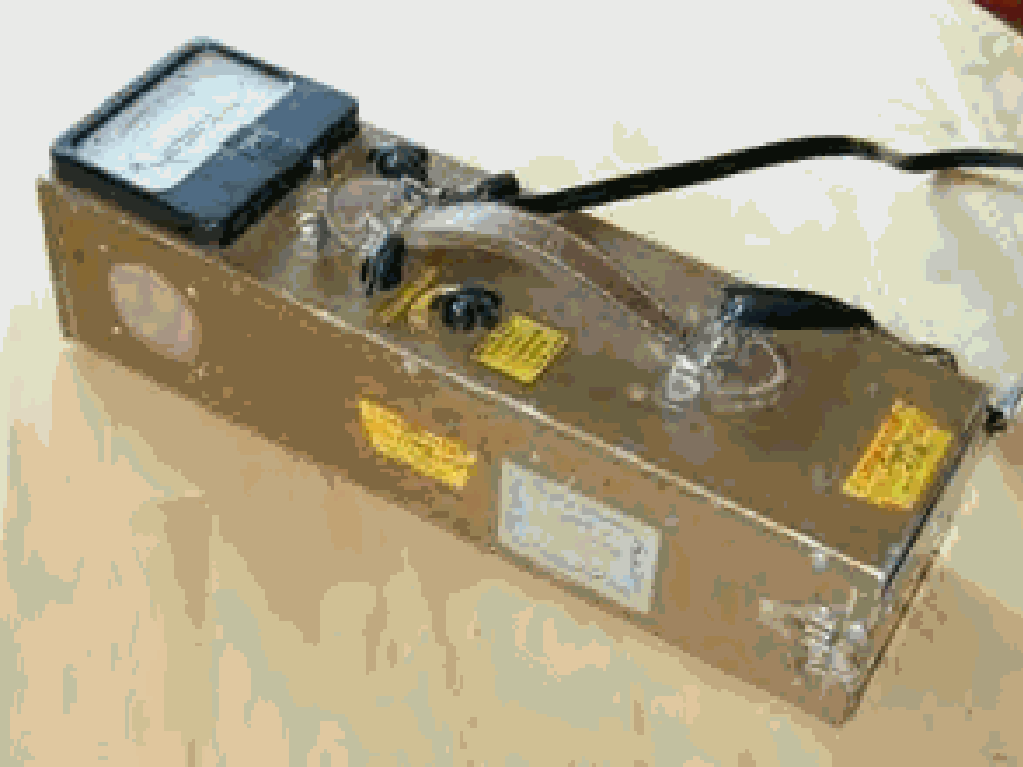
White’s Electronics
White’s Electronics was located at 1218 Main Street in Sweet Home, OR in 1954. The Oremaster series of Geiger counters was developed and designed for uranium prospecting along with a series of metal detectors.
The Model L3TSM-55 Super Geiger Counter was offered in 1955. It was advertised as 100 times more sensitive than other Geiger counters. It was advertised to “detect radiation in samples of uranium as small as a pinhead”. It detects beta, gamma, x-rays and cosmic rays. It employs three super sensitive Geiger tubes. It has a built-in directional feature to locate sources of radiation. It has a built in speaker "to use in rough terrain, snake country or in a car". The meter is 4.5” wide. It has 8 meter ranges, two which are adaptable for airborne or carborne surveys. It is powered by two 90-volt and two flashlight batteries. It has a “hammertoned beautiful aluminum case which is strong enough to hold a man’s weight”. It is 17” long x 5” wide x 4” high and weighs 7.5 lbs. It originally sold for $295.

Oremaster Super Geiger Counter 1954
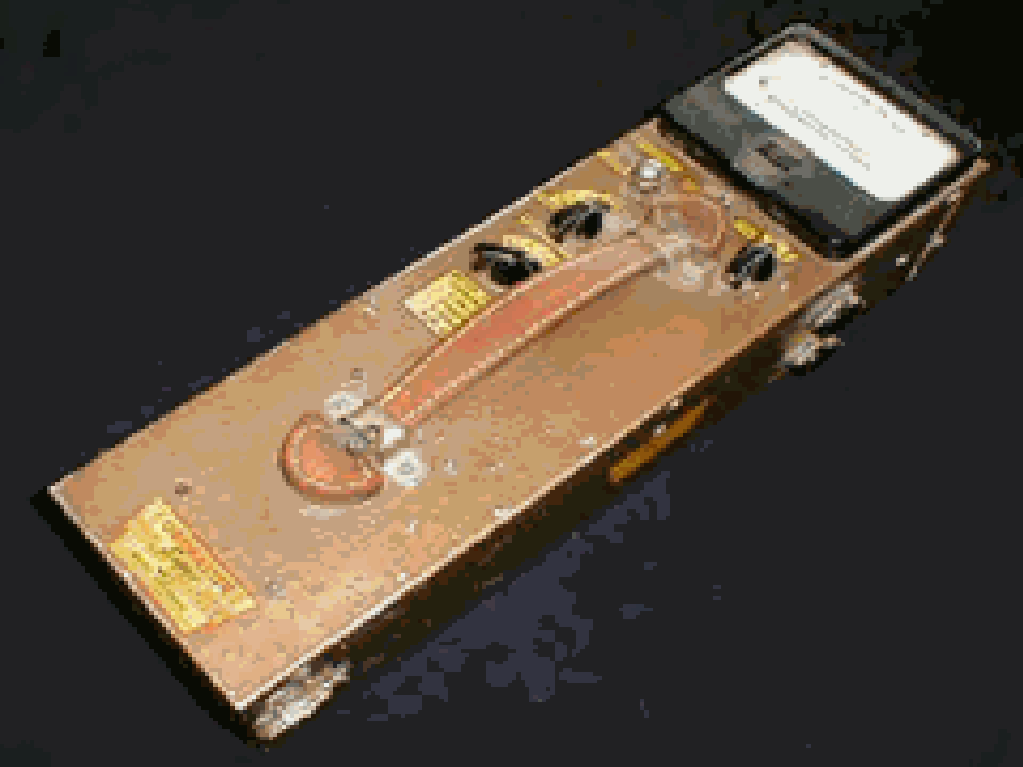
Oremaster Super Geiger Counter
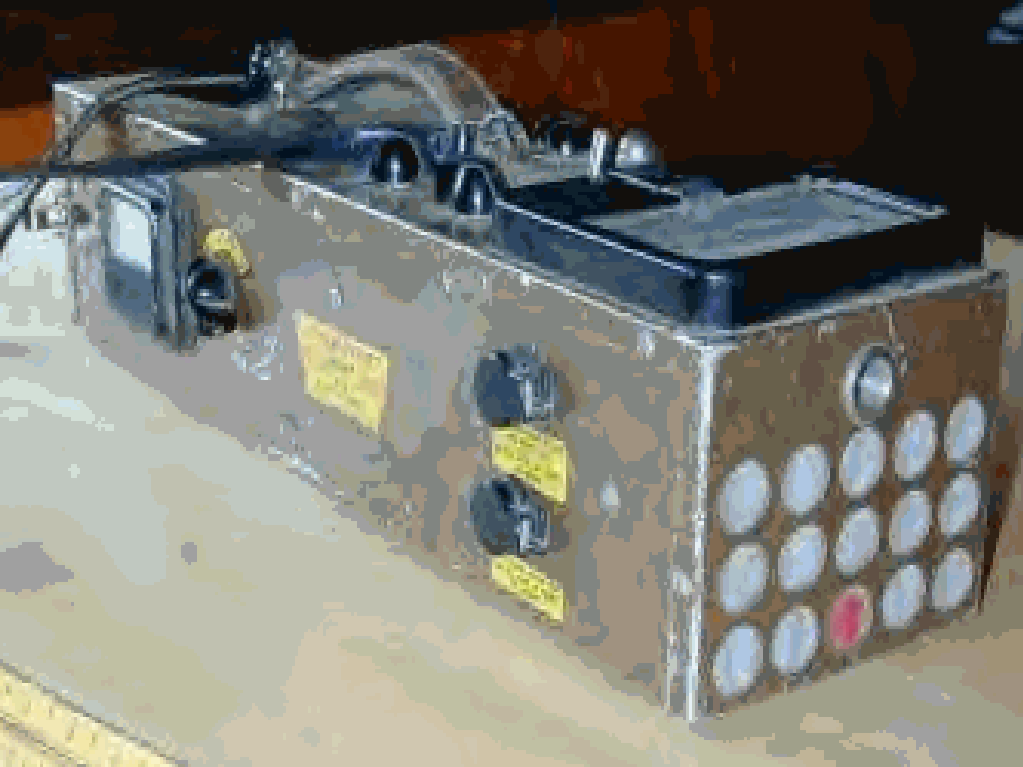
White’s Oremaster Super Front View
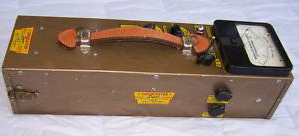
White's Oremaster Super Geiger Counter
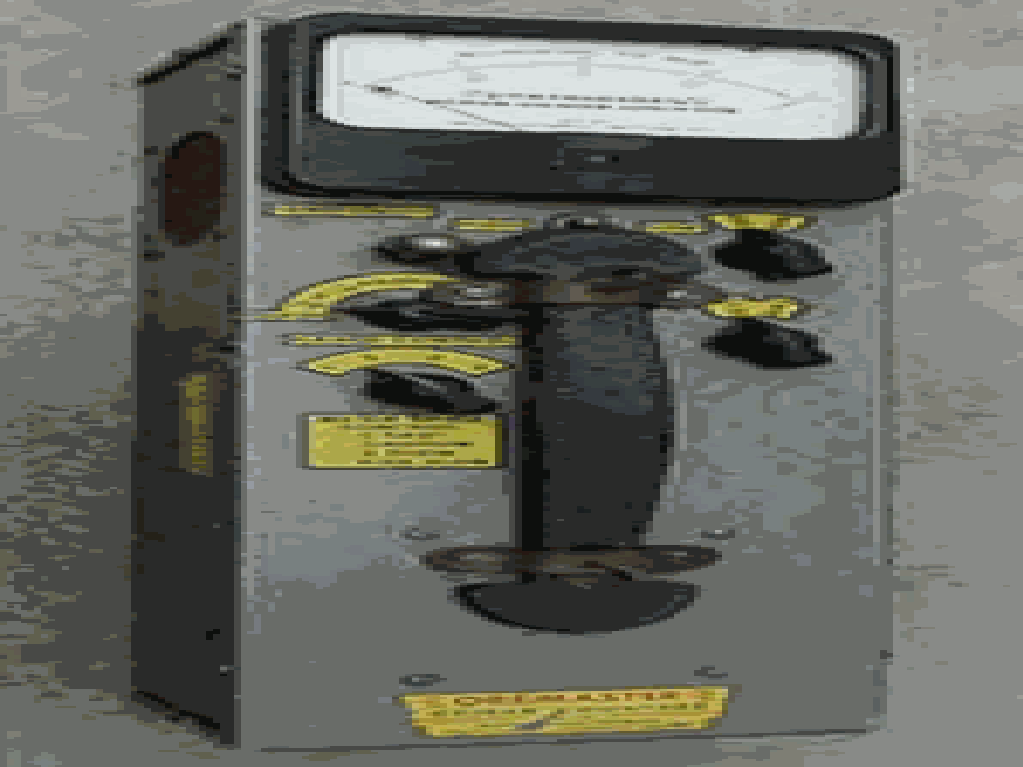
Oremaster Super Geiger Counter
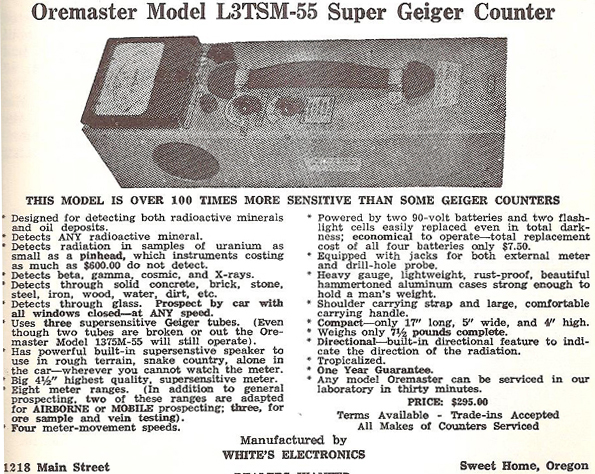
White's Oremater Model L3TSM-55 Super Geiger Counter Ad 1955
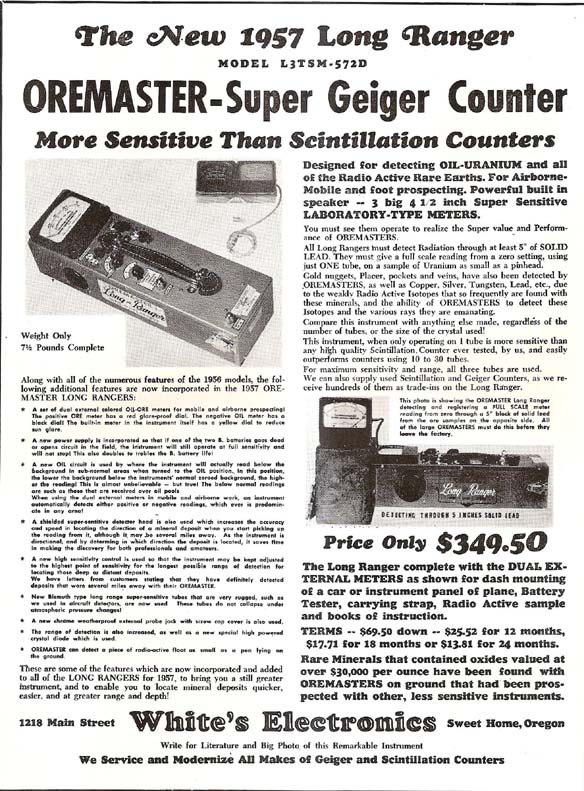
White's Oremater Model L3TSM-572D Super Geiger Counter Ad 1960
The Model L3TSM-56 was introduced in 1956. It has three thin-walled GM tubes located in the front end of the case by the holes. The holes allow betas to enter the tubes. For the high setting, all three tubes are used. For the low setting, only one tube is used. It has three ranges from 0.2, 2 and 20 mR/h. It measures 17” x 4.75” x 4”. It uses two 1.5, one 22.5 and two 90 volt batteries.
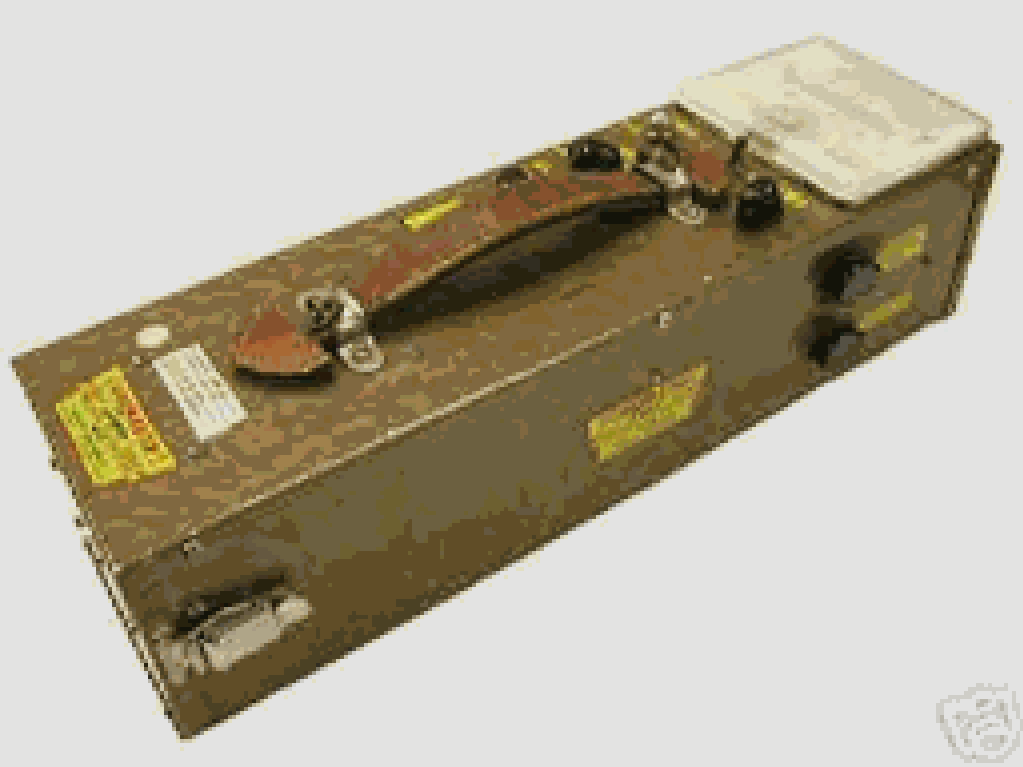
White’s Model L3TSM-56 1956
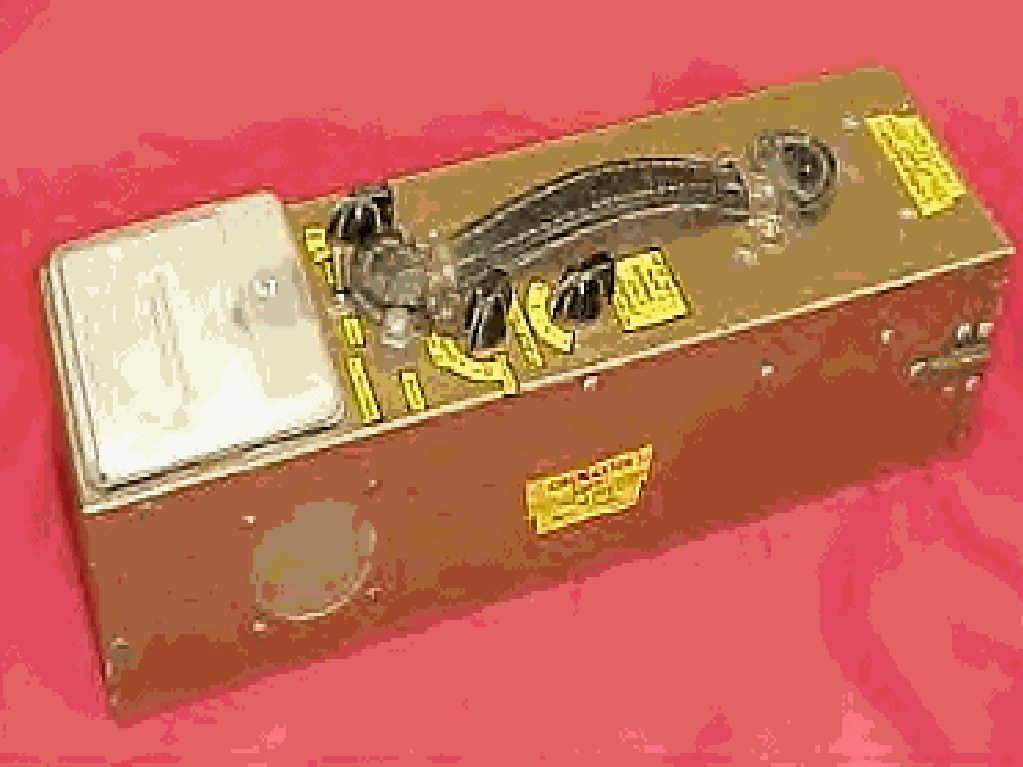
White’s Oremaster Model LSTSM-56
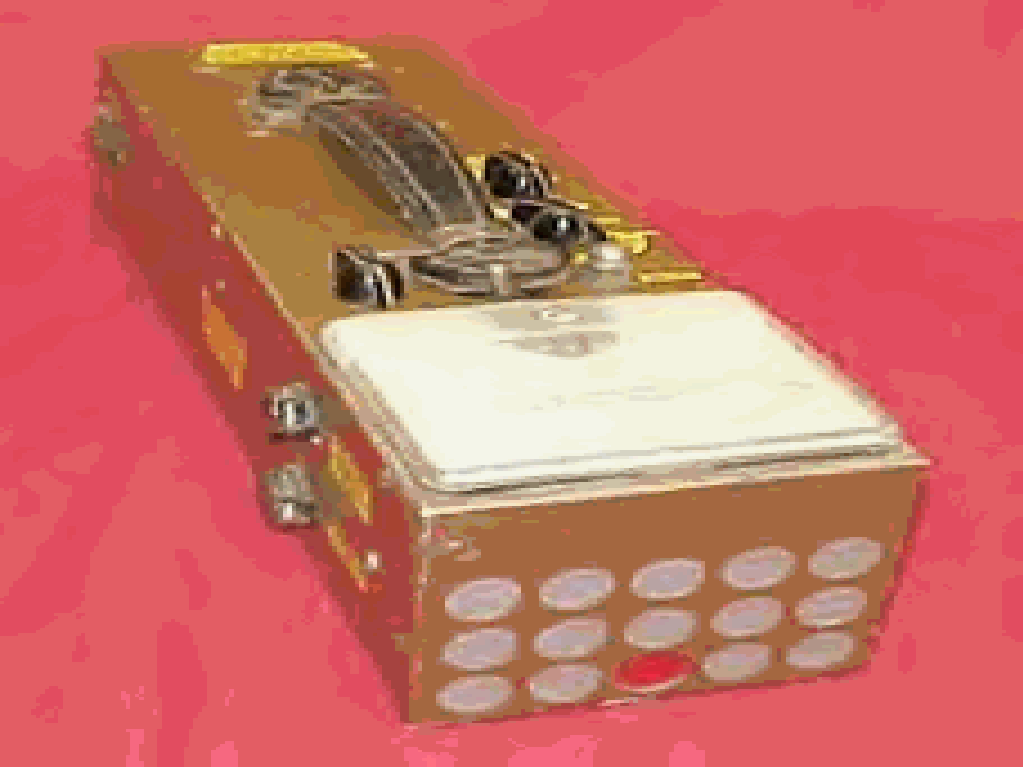
White’s Oremaster Model LSTSM-56
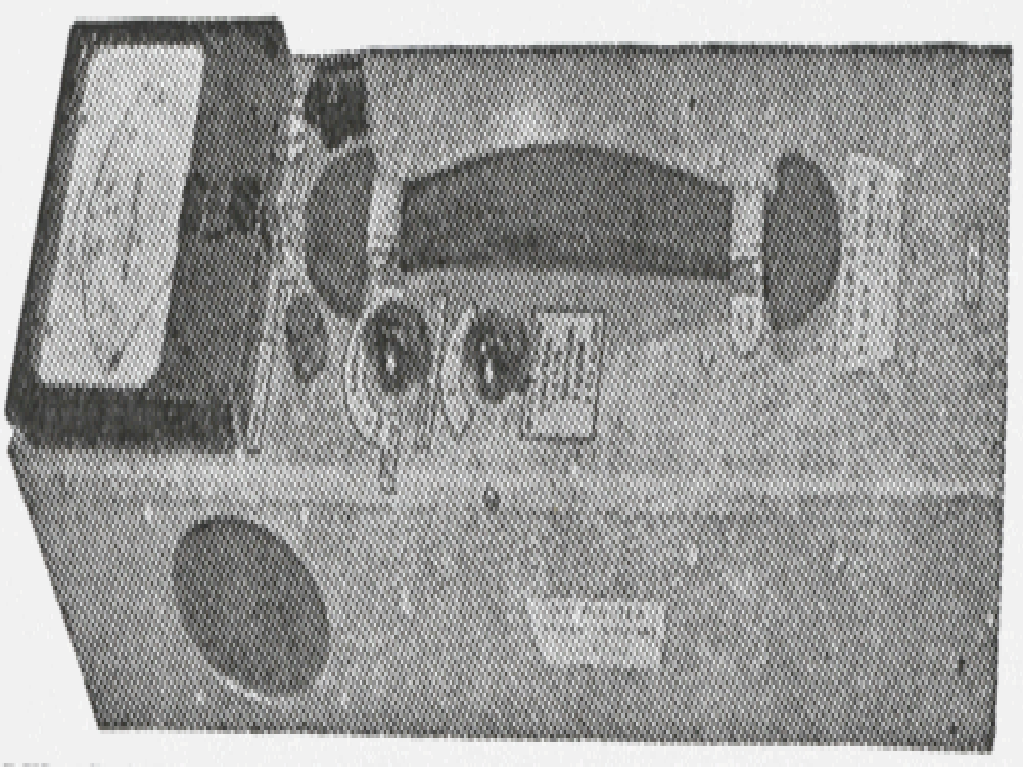
White’s Model L3TSM-55 1954
The Models L3TSM-55 or 56 could be upgraded to the sensitivity of the L3TSM-56Z for $25.
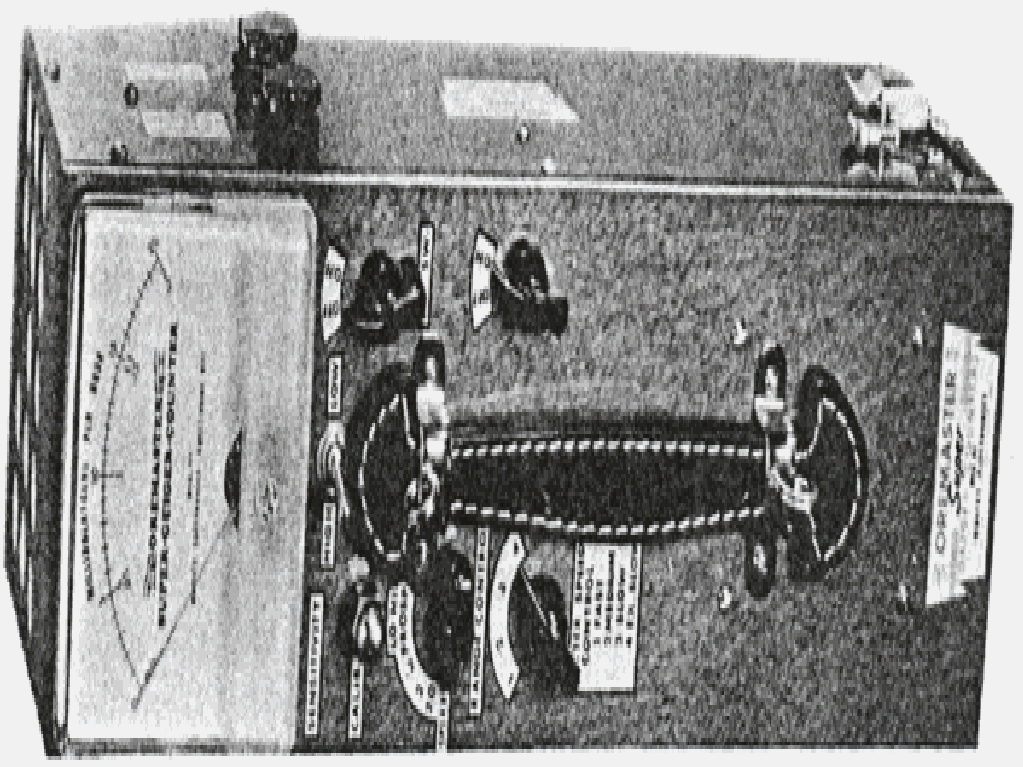
White’s Model L3TSM-56Z 1955
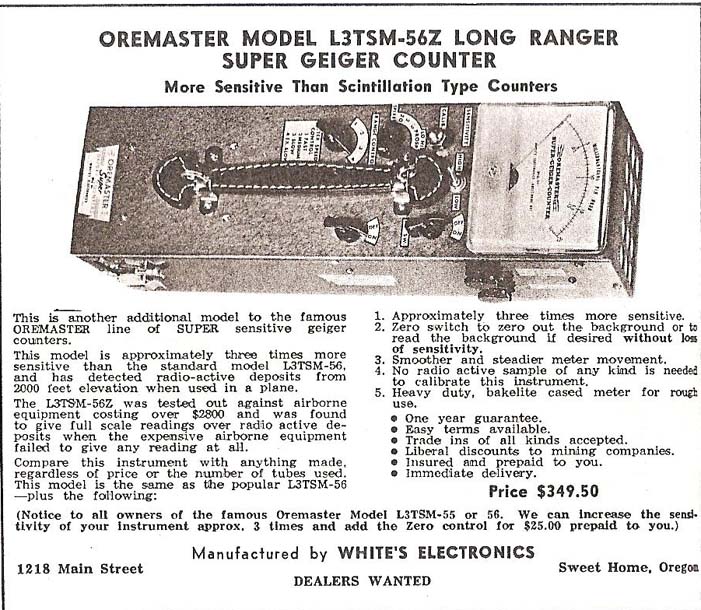
White's Oremater Model L3TSM-56Z Long Range Super Geiger Counter Ad 1955
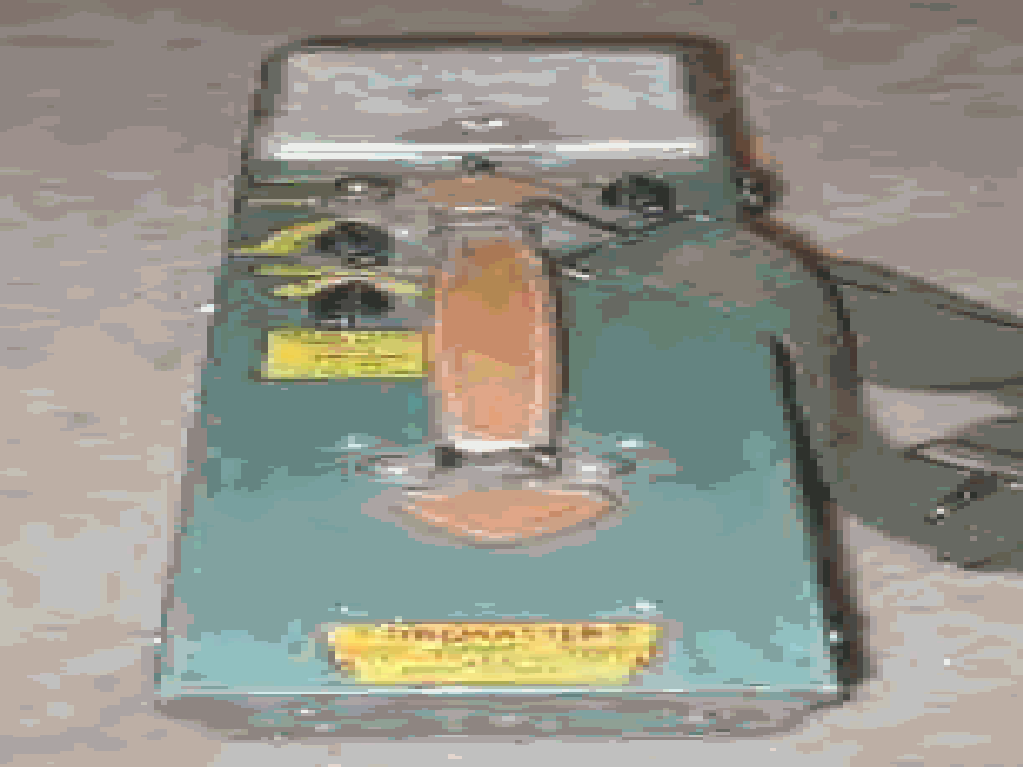
White’s Model LT3SM-56 1956
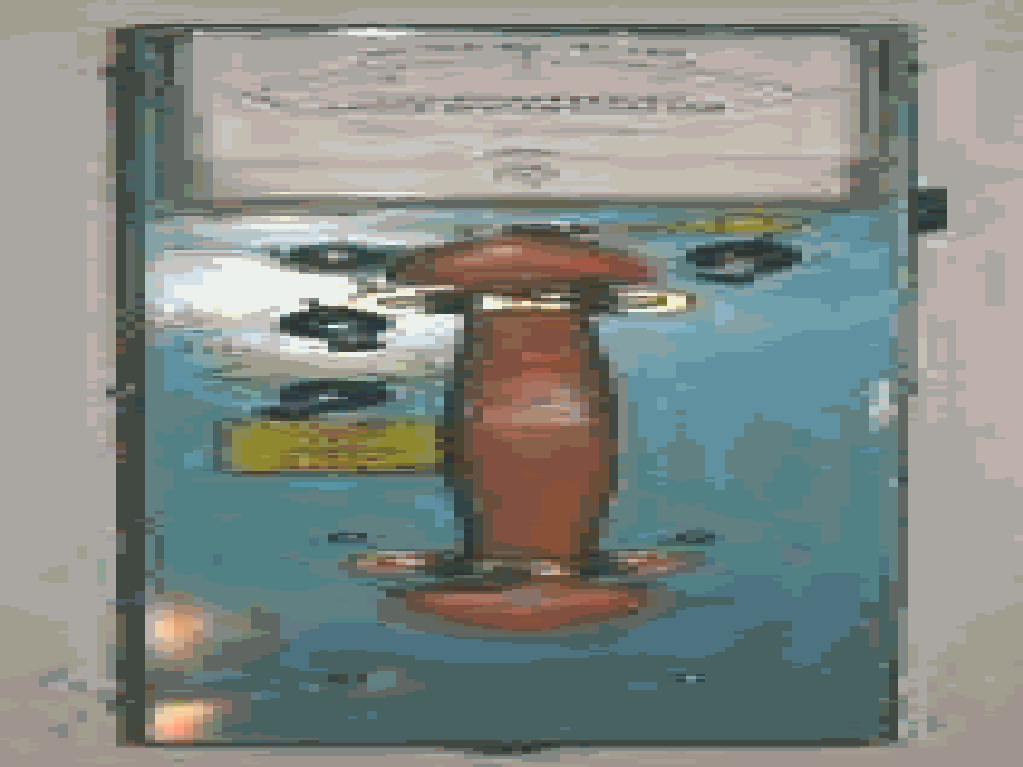
Whites’s Model LT3SM-55
The Oremaster Model L3TSM-56Z was the Long Ranger Super Geiger Counter introduced in 1955. It was three times more sensitive than the L3TSM-56 and is the same with a few additions. It contains three supersensitive Geiger tubes and will operate as long as one tube is operational. It has 8 meter ranges, two of which are adapted for aerial or carborne surveys. It is powered by two 90 volt and two flashlight batteries. It can also be adapted for external meter or drill probe. It has a built in directionality feature. It contains a zero switch to zero out background without loss of sensitivity. The unit does not require a radioactive source to calibrate. It has a heavy duty bakelite case for rough use. The unit is 17” long x 5” wide x 4” high. The cost in 1955 was $349.50. It claims to detect uranium deposits from 2000’ elevation in an airplane. You could also "prospect by car with the windows up at any speed". It weighs 7.5 lbs.
It was considered a bulky unit containing a directional Geiger tube. Controls included the time constant, zero control, meter light, and battery test circuit. The directionality was useful in locating where a radiation reading was originating. The procedure was to hold the unit waist high with the meter pointing away from you and the back end (batteries) pushed against your stomach. You would then make a complete turn watching the meter closely. The highest reading is the direction of the uranium ore deposit. You would then proceed towards the deposit watching the meter increase. The unit had a speaker to monitor radiation changes. On low, only one Geiger tube is used and on high, three Geiger tubes are used. In the Prospect mode, the full scale reading is 0.015 mR/h to 20 mR/h. Oremaster units operated on five batteries - two 90, two 1.5, and one 22.5 volt. Each unit came with a external meter and an ore sample. The owners manual "encourages use of the speaker in order to keep on the look out for rattlesnakes".
The unit can also be used in mobile and aerial prospecting. In aircraft, the unit must be shielded from the radium dials in the aircraft instrument panel. To use in this mode, lead shields are provided that fit over the Oremasters. For use in a car, it is noted that you do not have to open the window since the unit is so sensitive that it can detect through glass and metal of your car. Large 4.5 inch dash meters are available and plug into the instruments. Areas showing sub-normal radiation levels should be investigated as possible oil deposits.
The Long Ranger B.V. Model of the Super Geiger Counter was offered in 1956. This unit has an Oil-Ore switch. It could be used to detect oil, uranium and other radioactive materials. It has a 4.5” meter. It has a sensitivity control switch to use 1, 2 or 3 tubes. The unit sold for $545. Ken White claimed to be selling 800 units per month in 1956. He also indicated that he "outfitted a unit for use on a horse with the meter dashboard mounted on the saddle".
Need photo
White’s Long Ranger B.V. Model 1956
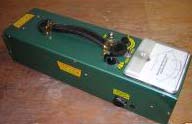
White's Oremaster SR724 Super Geiger Counter
A new weatherproof “Alaska” Oremaster Geiger counter was available in 1956.
Need photo
White’s “Alaska” Oremaster 1956
The Model L3TSM-56Z Long Ranger Super Geiger Counter was offered in 1956. It has a quick detachable meter for airborne and mobile prospecting. The unit sold for $349.50.
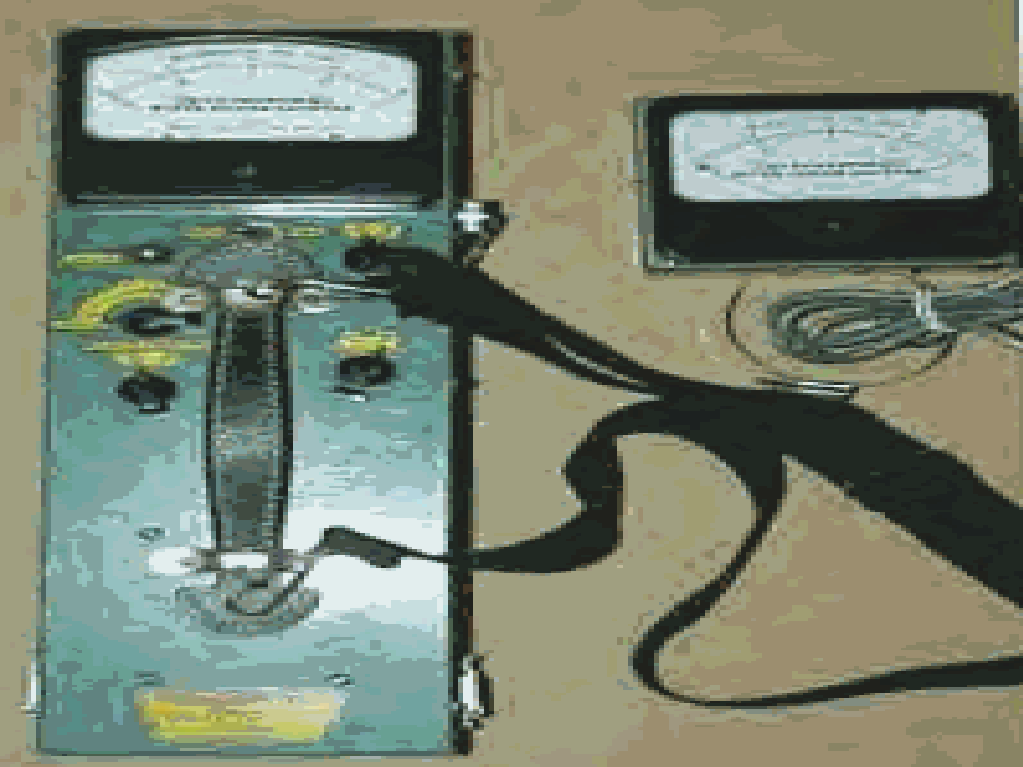
White’s Oremaster Long Ranger Super
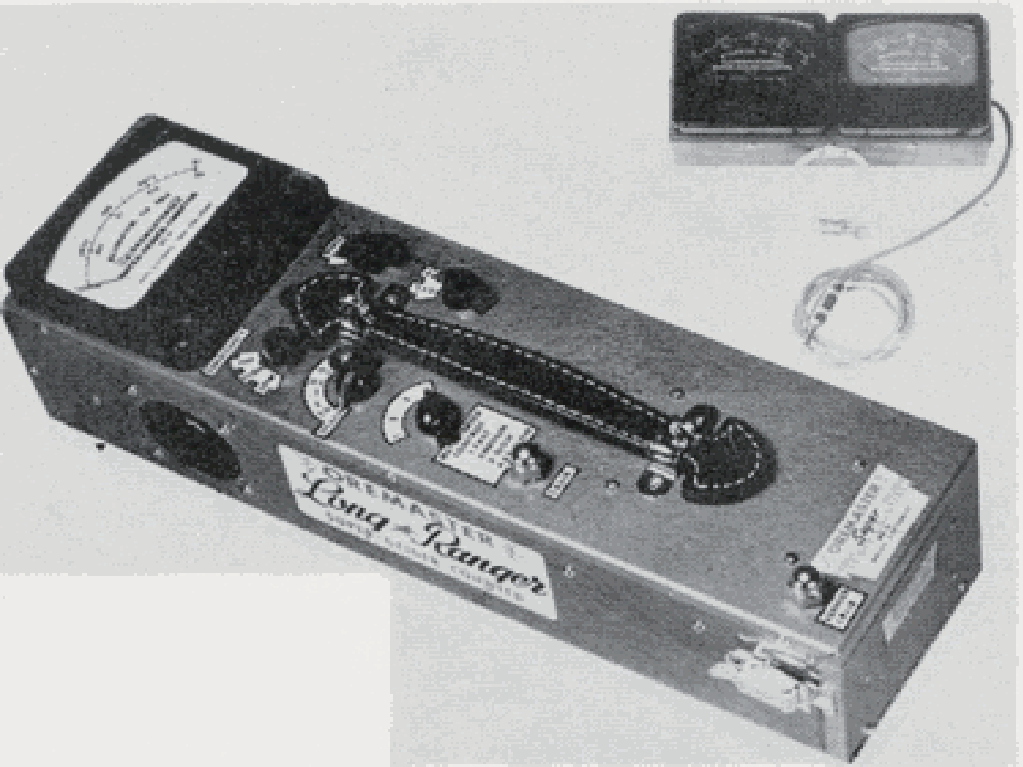
White’s Oremaster Long Ranger 1957
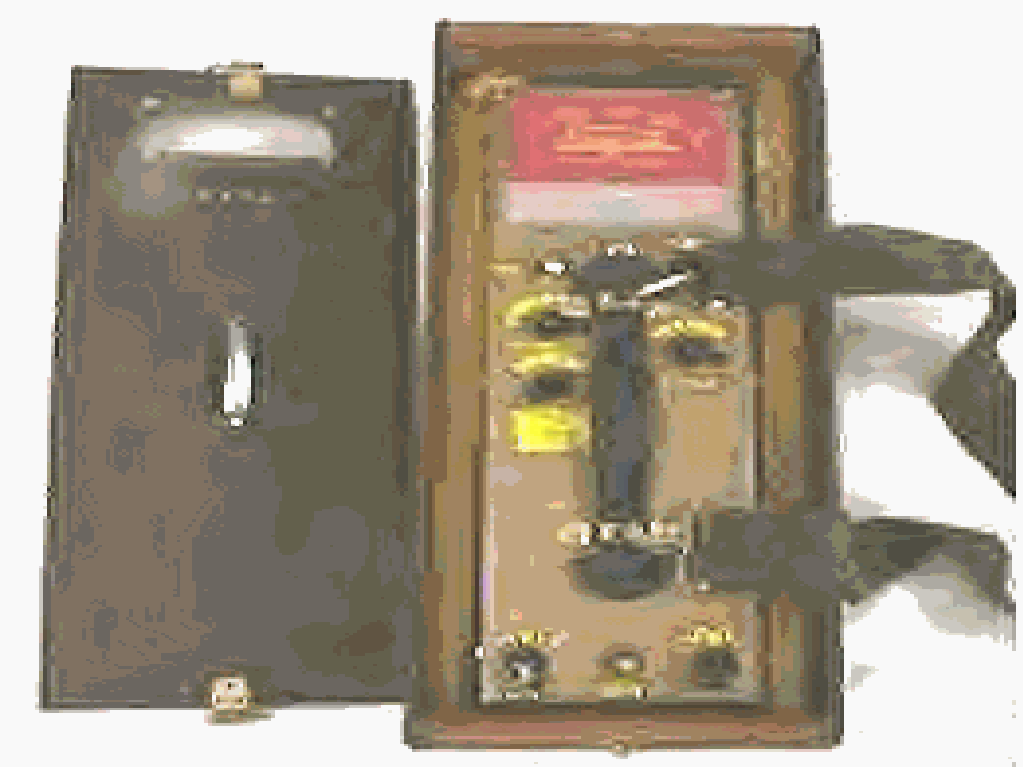
Oremaster Long Ranger Super Geiger Counter
The Long Range Oremaster Super Geiger Counter, Model L3TSM-57ZB (bismuth), is another unit designed for the detection of radioactive materials. The unit contains three tubes - two thin-walled Victoreen Bismuth Geiger tubes and one-thin walled Victoreen Thyrode Geiger tube. In the low position, only the Thyrode tube was used. This tube was to be used to locate surface deposits or ore samples. The two tube setting was used to located buried deposits. Sensitivity range was from 0.015 to 20 mR/h. Meter speed ranged from fast for mobile and aerial prospecting to extra slow for walking and sample testing. The calibration adjust was located under the chrome cap marked CALIB. To test a sample, place it 1 inch from red dot on front of unit. The unit has a probe jack which can be used with an external probe, pitmaster, or 360 degree detection head, all sold as accessories.
The Dual Long Ranger was offered in 1958. It was designed for the detection of mineral and oil deposits. It had fifteen ranges of meter sensitivity and had directional sensitivity. It had an Oil-Ore automatic detection circuit. It could detect oil, uranium, rare earth’s and other “radio-active” minerals. It had two 4.5” plug in meters for steering a car or for the instrument panel of an airplane. It had the option to use one, two or three tubes for added sensitivity. It had two meters, one for sub-normal detection of oil, gas or water, and one for mineral detection. It measures 4”x17”x4” and weighs 8 lbs. It sold for $595.
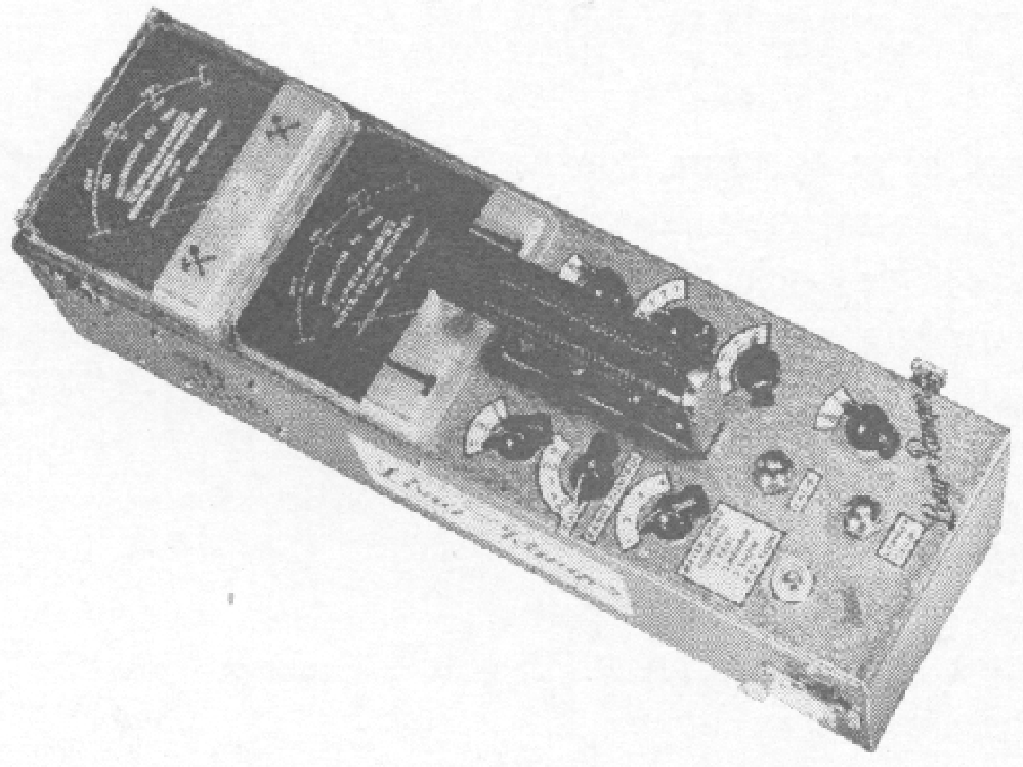
Oremaster Dual Long Ranger 1958
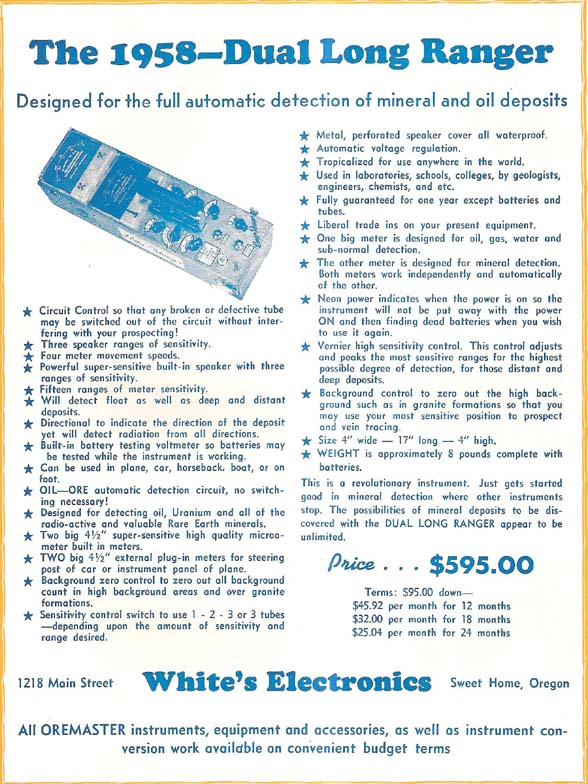
White's Oremater Dual Long Ranger Super Geiger Counter Ad 1958
The Oremaster "Rockhound" Super Geiger Counter was available in 1956 for uranium exploration. It is sensitive enough for airborne and mobile prospecting. It has a wide 4-1/2" Super Sensitive Meter and weighs only 5 lbs. It sold for $129.50.
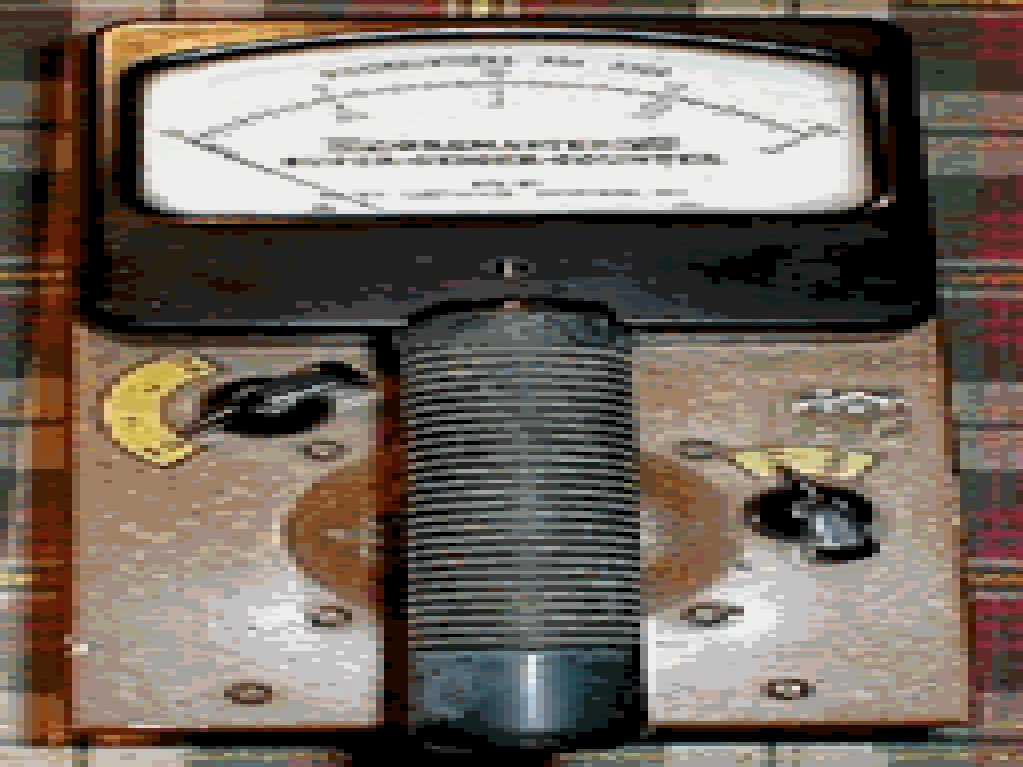
White’s Oremaster "Rockhound" Super Geiger 1956
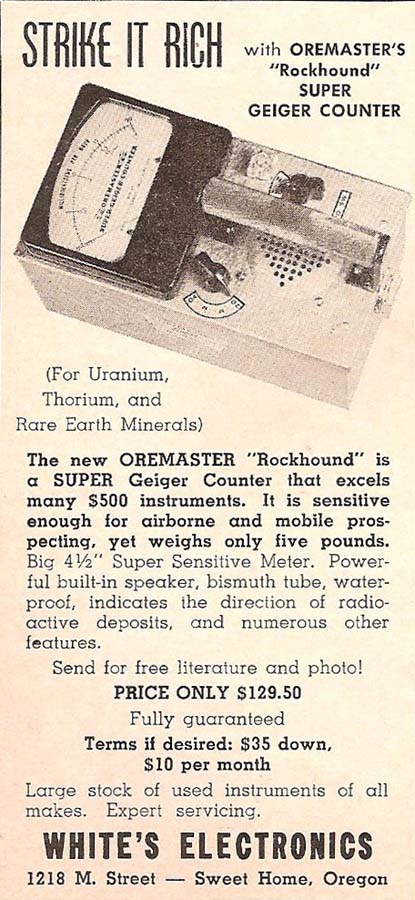
White's Oremaster Rockhound Super Geiger 1956
The Oremaster Super X100 was a scintillation counter. It was advertised as “approximately 5 times as sensitive as a $5,000 instrument and 25 times as sensitive as regular scintillation counters”. The unit has a sodium iodide crystal and photomultiplier tube. The unit measures 10” long x 8” high x 8” wide and weighs 12 lbs. It was designed to outline or trace buried ore bodies, veins, pockets, and oil anomalies. The unit will detect faint uranium ore deposits that may be accompanying other non-radioactive precious minerals. It had an Oil-Ore selector switch. Scintillators can be flown in aircraft at altitudes about 100 feet. It had 11 sensitivity ranges from 0.001 to 100 mR/h. For aerial use, two external meters are provided. The meter with the red dial shows the above normal readings. The meter with the black dial shows the sub-normal readings. In a sub-normal reading, the red dial will fall below zero. This indication may lead to an oil pool, underground lake or high grade iron deposit. It used one 90 volt, one 22.5 volt, and four flashlight batteries. An option was the “lead shielder” air probe for pin pointing deposits from the air. It also came with a beautiful wooden storage case. It sold for $1295.
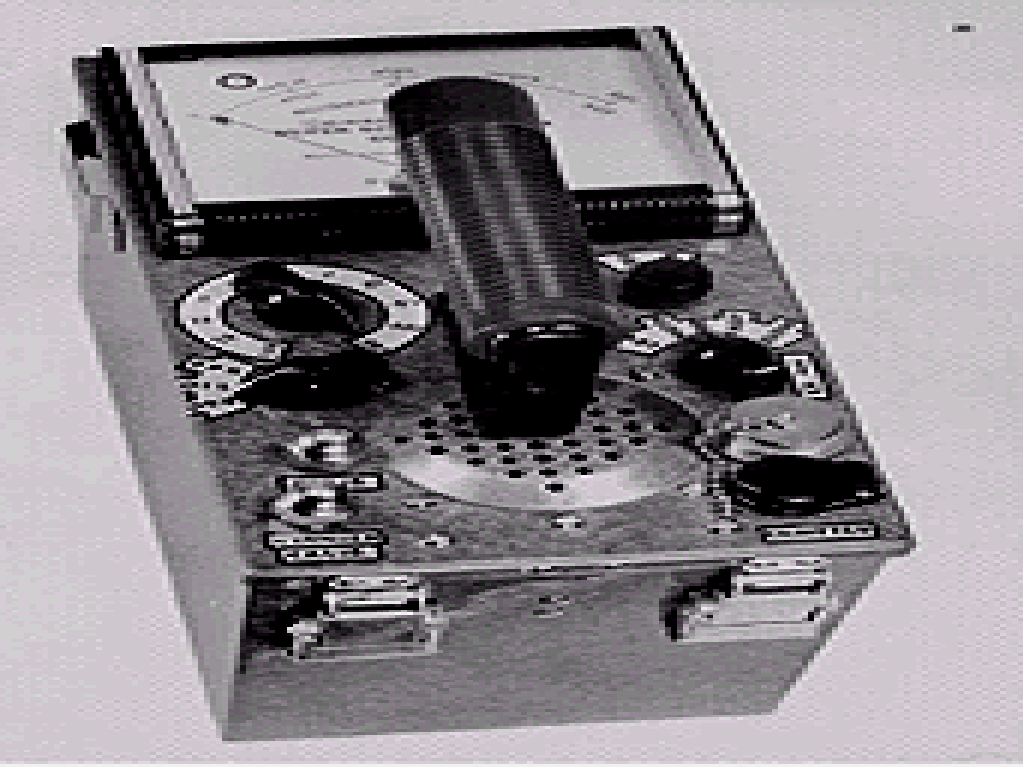
Oremaster Super X100
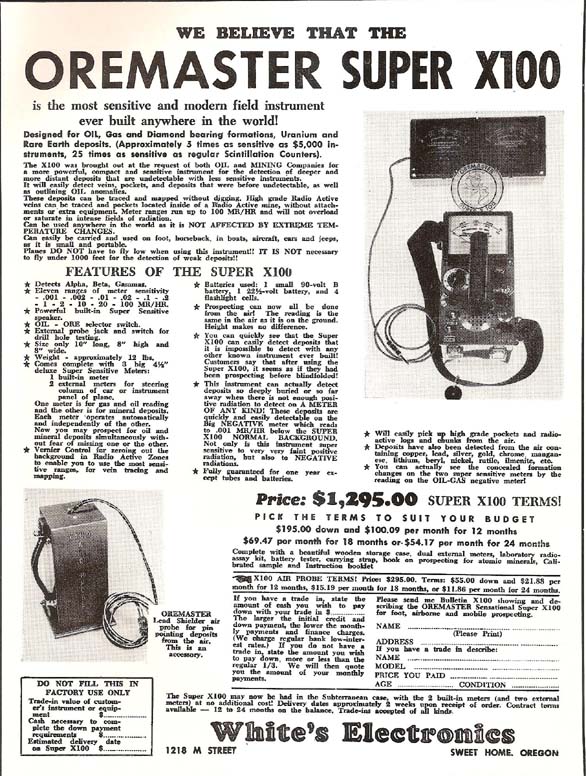
White's Oremaster Model Super X100 Geiger Counter Ad 1960
The Oremaster Long Range, Model C1 Super Geiger counter is designed to be inexpensive for the general user. The unit has the larger 4.5 inch meter, four sensitivity ranges, two meter speeds, and is directional. The detector is a thin-walled, beta-gamma tube. The unit is housed in an aluminum case and is rustproof. It is 17” long x 5” wide x 4” high and weighs 6 lbs. The unit sold for $199. The instructions indicate that "unless there is bomb fallout in the area, a high reading over a wide area will possibly indicate the presence of a large radioactive ore body - either uranium or thorium".
The Oremaster “Forty Niner” was offered in 1958. It was a sensitive probe with three detectors for detecting “feeble ray emanations from mineral deposits”. The probe was 5” x 5” x 2.5” with the underside perforated to “allow detection of weaker rays and electrons”. It came with a power supply control unit attached by a cable to the probe. It sold for $295.
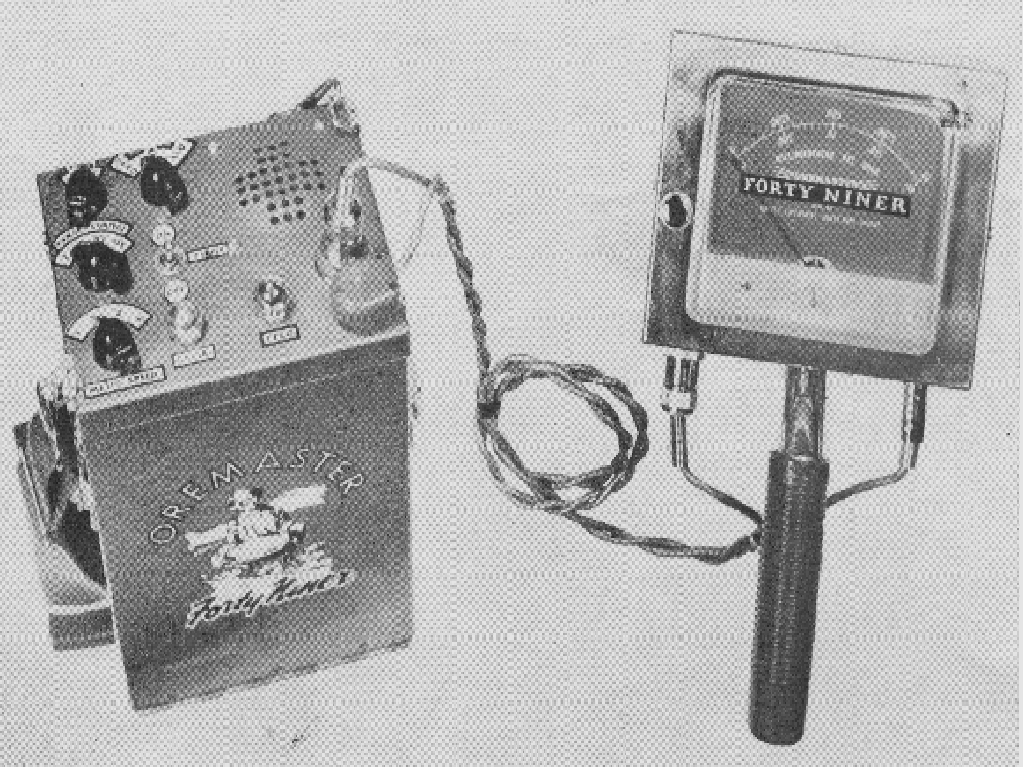
Oremaster Forty Niner 1958
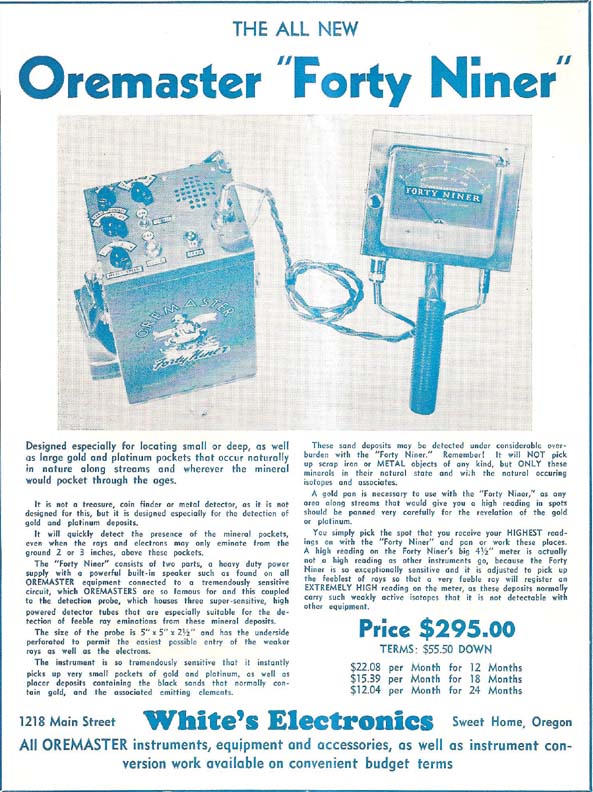
White's Oremaster Forty Niner Geiger Counter Ad 1960
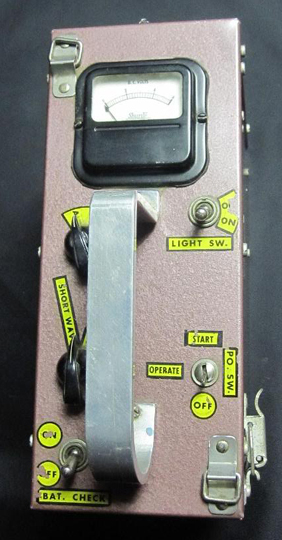
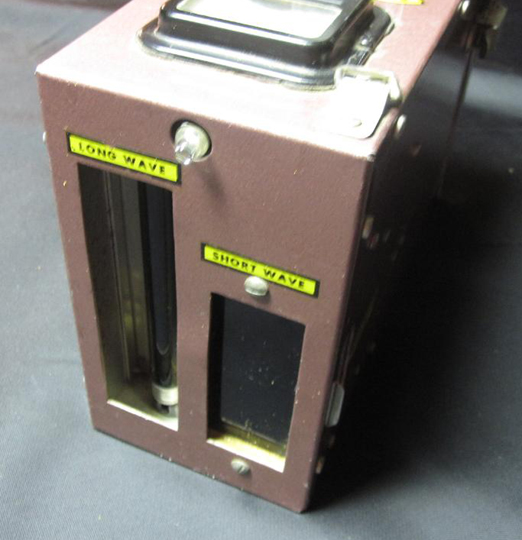
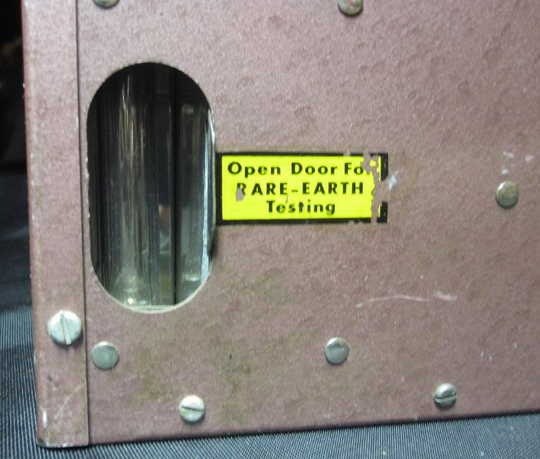
White's Oremaster Super Geiger Counter Three Way 1950's
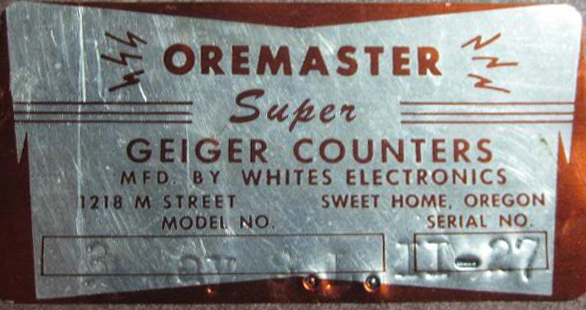
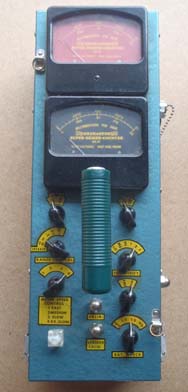
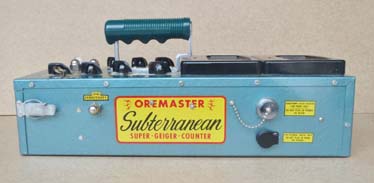

White's Oremater Subterranean Super Geiger Counter Ad 1955
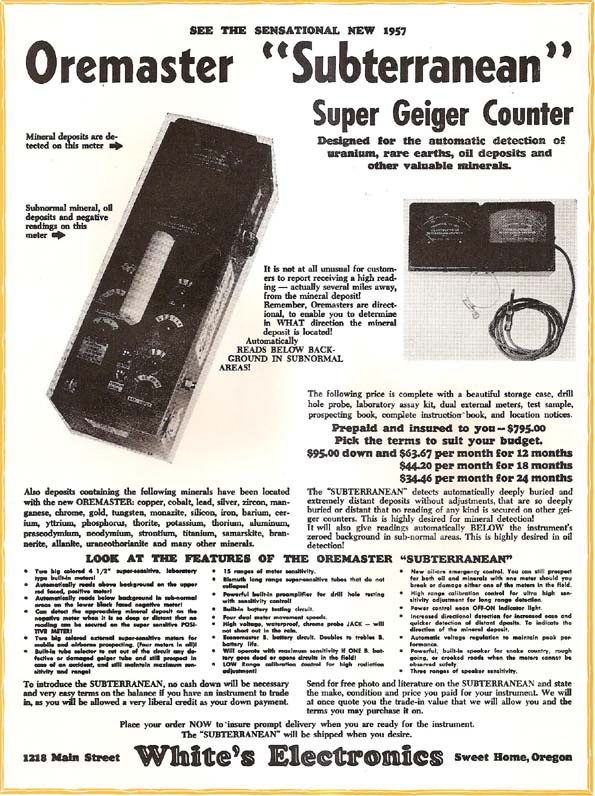
White's Oremater Subterranean Super Geiger Counter Ad 1960